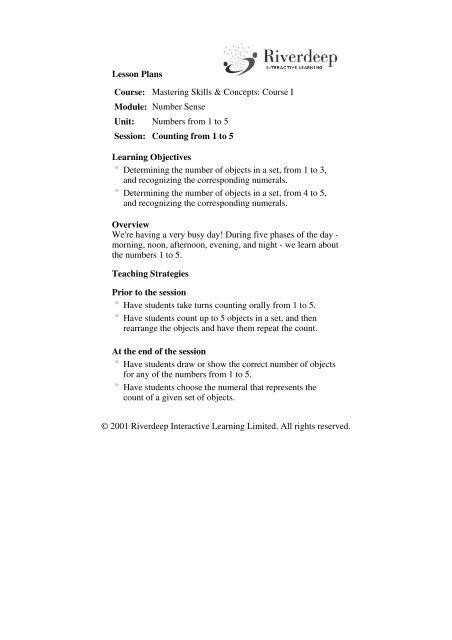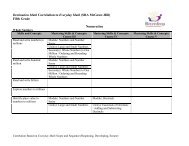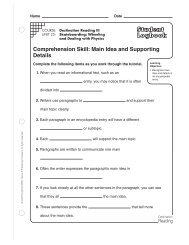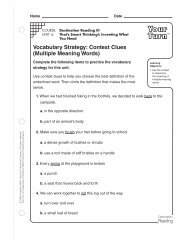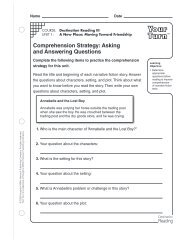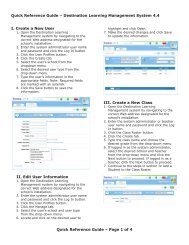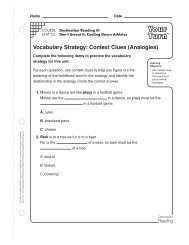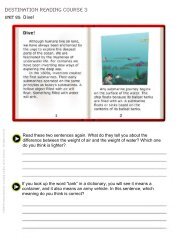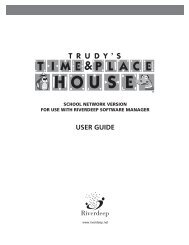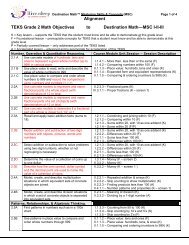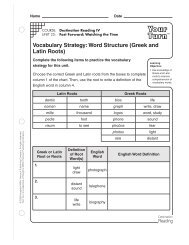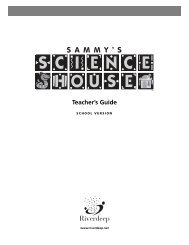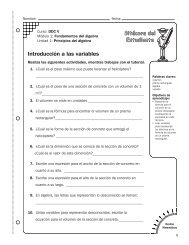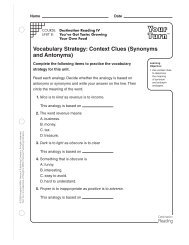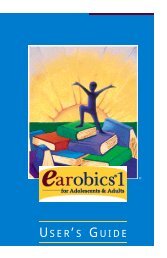Lesson Plans Course: Mastering Skills & Concepts: Course I Module ...
Lesson Plans Course: Mastering Skills & Concepts: Course I Module ...
Lesson Plans Course: Mastering Skills & Concepts: Course I Module ...
- No tags were found...
Create successful ePaper yourself
Turn your PDF publications into a flip-book with our unique Google optimized e-Paper software.
<strong>Lesson</strong> <strong>Plans</strong><strong>Course</strong>: <strong>Mastering</strong> <strong>Skills</strong> & <strong>Concepts</strong>: <strong>Course</strong> I<strong>Module</strong>: Number SenseUnit: Numbers from 1 to 5Session: Counting from 1 to 5Learning ObjectivesDetermining the number of objects in a set, from 1 to 3,and recognizing the corresponding numerals.Determining the number of objects in a set, from 4 to 5,and recognizing the corresponding numerals.OverviewWe're having a very busy day! During five phases of the day -morning, noon, afternoon, evening, and night - we learn aboutthe numbers 1 to 5.Teaching StrategiesPrior to the sessionHave students take turns counting orally from 1 to 5.Have students count up to 5 objects in a set, and thenrearrange the objects and have them repeat the count.At the end of the sessionHave students draw or show the correct number of objectsfor any of the numbers from 1 to 5.Have students choose the numeral that represents thecount of a given set of objects.© 2001 Riverdeep Interactive Learning Limited. All rights reserved.
<strong>Lesson</strong> <strong>Plans</strong><strong>Course</strong>: <strong>Mastering</strong> <strong>Skills</strong> & <strong>Concepts</strong>: <strong>Course</strong> I<strong>Module</strong>: Number SenseUnit: Numbers from 1 to 5Session: Creating Sets of 1 to 5Learning ObjectivesCreating sets containing 1 to 3 objects.Creating sets containing 4 to 5 objects.OverviewWe're in a cold and frosty place! We count warm sweatersand hats, pick up some ice-blocks to fix an igloo, and help ourfriend catch some fish.Teaching StrategiesPrior to the sessionHave students match sets of objects to the numerals thatshow how many objects are in each set.Have students read and match numerals to the count ofsets of objects.At the end of the sessionGive students more than 5 objects, and ask them to createsets that have fewer than 5 objects.Practice reading and writing the numerals from 1 to 5.© 2001 Riverdeep Interactive Learning Limited. All rights reserved.
<strong>Lesson</strong> <strong>Plans</strong><strong>Course</strong>: <strong>Mastering</strong> <strong>Skills</strong> & <strong>Concepts</strong>: <strong>Course</strong> I<strong>Module</strong>: Number SenseUnit: Numbers from 1 to 5Session: Creating Representations of the Numbers from1 to 5Learning ObjectivesCreating and recognizing representations of the numbersfrom 1 to 5.OverviewWe're fixing broken toys in the toy factory. We use chips anda 5-frame to show the number of toys.Teaching StrategiesPrior to the sessionHave students represent the number of objects in a setwith the corresponding numeral.Create black-line masters for a 5-frame or a 10-frame, andhave students use chips in any arrangement to show thenumerals from 1 to 5.Have students place a set of chips in various positionswithin a 5-frame or a 10-frame, and then repeat the count.At the end of the sessionHave students use chips or counters to represent thenumber of objects within a set.Have students write the corresponding numeral thatmatches the number of chips or counters in a 5-frame or a10-frame.Count the number of different objects in set and use chipsor counters to make a picture graph that represents the set.© 2001 Riverdeep Interactive Learning Limited. All rights reserved.
<strong>Lesson</strong> <strong>Plans</strong><strong>Course</strong>: <strong>Mastering</strong> <strong>Skills</strong> & <strong>Concepts</strong>: <strong>Course</strong> I<strong>Module</strong>: Number SenseUnit: Numbers from 1 to 10Session: Counting from 5 to 10Learning ObjectivesDetermining the number of objects in a set, from 6 to 8,and recognizing the corresponding numerals.Determining the number of objects in a set, from 9 to 10,and recognizing the corresponding numerals.OverviewWe're building a house. We count the number of constructionworkers, and the number of different items they need tocomplete the job.Teaching StrategiesPrior to the sessionHave students take turns counting orally from 5 to 10.Have students count up to ten objects in a set, and thenrearrange the objects and have them repeat the count.At the end of the sessionHave students use counters or chips to show the numberof objects in a given set.Have students choose the numeral that represents thenumber of objects in a given set.Practice reading and writing the numerals from 5 to 10.© 2001 Riverdeep Interactive Learning Limited. All rights reserved.
<strong>Lesson</strong> <strong>Plans</strong><strong>Course</strong>: <strong>Mastering</strong> <strong>Skills</strong> & <strong>Concepts</strong>: <strong>Course</strong> I<strong>Module</strong>: Number SenseUnit: Numbers from 1 to 10Session: Creating Sets of 5 to 10Learning ObjectivesCreating sets containing 5 to 10 objects.OverviewWe're hard at work on a farm, and we're getting hungry! Wecount the number of ingredients we need to make soup.Teaching StrategiesPrior to the sessionHave students match sets of objects to the numerals thatshow how many objects are in each set.Have students read and match numerals to the count ofsets of objects.At the end of the sessionGive students more than ten objects and ask them tocreate sets that have ten or fewer than ten objects.Practice reading and writing the numerals from 5 to 10.© 2001 Riverdeep Interactive Learning Limited. All rights reserved.
<strong>Lesson</strong> <strong>Plans</strong><strong>Course</strong>: <strong>Mastering</strong> <strong>Skills</strong> & <strong>Concepts</strong>: <strong>Course</strong> I<strong>Module</strong>: Number SenseUnit: Numbers from 1 to 10Session: Creating Representations of the Numbers from5 to 10Learning ObjectivesCreating and recognizing representations of the numbersfrom 5 to 10.OverviewIt's time for some chickens to return to their coop. We showthe number of chickens in the coop using a ten-frame andchips.Teaching StrategiesPrior to the sessionHave students represent the number of objects in a setwith the corresponding numeral.Create black-line masters for a 10-frame, and havestudents use chips in any arrangement to represent thenumerals from 5 to 10.Have student place a set of chips in various positionswithin a 10-frame and repeat the count for eacharrangement.At the end of the sessionHave students place chips or counters in a 10-frame torepresent a number and/or the number of objects within aset.Have students write the numeral that matches the numberof chips or counters in a 10-frame.Given a set of chips or counters in a 10-frame, havestudents make up a story about what these chips represent.Have students identify the count, and draw or show howmany objects are in a set, given a number of chips orcounters placed in any order in a 10-frame.© 2001 Riverdeep Interactive Learning Limited. All rights reserved.
<strong>Lesson</strong> <strong>Plans</strong><strong>Course</strong>: <strong>Mastering</strong> <strong>Skills</strong> & <strong>Concepts</strong>: <strong>Course</strong> I<strong>Module</strong>: Number SenseUnit: Numbers from 1 to 10Session: One More ThanLearning ObjectivesNaming the numbers that are one more than 1, 2, 3, 4, and5.Naming the numbers that are one more than 6, 7, 8, 9, and10.OverviewA juggler is entertaining the crowd at a carnival. We use chipsand 5-frames to show the number of objects the juggler canjuggle and balance.Teaching StrategiesPrior to the sessionHave students repeat orally the counting sequence from 1to 10.Starting in a corner cell in a 10-frame, have students insertchips or counters to represent the numbers, in order, from1 to 10.At the end of the sessionDraw a "one more than machine" on the chalkboard andask students what number will come out of the machinewhen you insert a number from 1 to 9.Give students copies of black-line masters having sets offive 10-frames, and have students use counters todemonstrate and discuss what is meant by "one morethan" a given number.Use arrow diagrams and number strips to show one morethan each number from 1 to 9.© 2001 Riverdeep Interactive Learning Limited. All rights reserved.
<strong>Lesson</strong> <strong>Plans</strong><strong>Course</strong>: <strong>Mastering</strong> <strong>Skills</strong> & <strong>Concepts</strong>: <strong>Course</strong> I<strong>Module</strong>: Number SenseUnit: Numbers from 1 to 10Session: One Fewer Than and ZeroLearning ObjectivesNaming the numbers that are one fewer than 5, 4, 3, 2,and 1.Using "0" to represent the number of objects in an emptyset.Naming the numbers that are one fewer than 10, 9, 8, 7,and 6.OverviewWe're at an afternoon concert in the park. The musicians areleaving the stage one by one. We use chips and 5-frames toshow the number of musicians that are left.KeywordsZeroTeaching StrategiesPrior to the sessionHave students practice counting backwards from 5 to 0,and from 10 to 0.Give students copies of black-line masters having at leastfive 10-frames and then, starting at a corner cell, havestudents use counters to display the numbers from 5 to 1;repeat for the numbers from 10 to 5.Ask students how they could represent a collection thathad nothing in it, e.g. an empty jar of candy.At the end of the sessionDraw a "one fewer than machine" on the chalkboard andask students what number will come out of the machinewhen you insert a number from 1 to 5 and/or from 5 to 10.Give students black-line masters having multiple 10-frames and have them use counters to demonstrate anddiscuss what is meant by "one fewer than" a givennumber.© 2001 Riverdeep Interactive Learning Limited. All rights reserved.
<strong>Lesson</strong> <strong>Plans</strong><strong>Course</strong>: <strong>Mastering</strong> <strong>Skills</strong> & <strong>Concepts</strong>: <strong>Course</strong> I<strong>Module</strong>: Number SenseUnit: Numbers to 100Session: Counting from 10 to 20Learning ObjectivesRecognizing the numerals and word names for thenumbers from 11 to 15.Using 10-frames to count and create sets of objects from11 to 15.Recognizing the numerals and word names for thenumbers from 16 to 20.Using 10-frames to count and create sets of objects from16 to 20.OverviewA diver is underwater, looking for pearls. We use 10-framesto count the pearls, and we learn the word names for thenumbers.Teaching StrategiesPrior to the sessionHave students count orally to 20 to determine how manyknow the correct sequence and word names of thenumbers.Have each student use pairs of 10-frames to representnumbers up to 20 as combinations of ten and ones.At the end of the sessionHave students match combinations of ten and ones to thecorresponding word name and numeral of two-digitnumbers within 20.Call out the numbers between 10 and 20 and havestudents show a corresponding representation of thenumber and its numeral.© 2001 Riverdeep Interactive Learning Limited. All rights reserved.
<strong>Lesson</strong> <strong>Plans</strong><strong>Course</strong>: <strong>Mastering</strong> <strong>Skills</strong> & <strong>Concepts</strong>: <strong>Course</strong> I<strong>Module</strong>: Number SenseUnit: Numbers to 100Session: Counting from 20 to 50Learning ObjectivesRecognizing the numerals and word names for thenumbers from 20 to 30.Counting and creating sets of objects from 20 to 30.Recognizing the numerals and word names for thenumbers from 30 to 50.Counting and creating sets of objects from 30 to 50.OverviewWe're at the airport, counting suitcases on a conveyor belt.We use blocks to count the number of passengers on a planeand the number of suitcases that have fallen out.Teaching StrategiesPrior to the sessionHave students count by ones orally to 50 to determinehow many know the correct sequence and word names ofthe numbers.Distribute black-line masters of a blank 10 x 5 array andhave students fill in the array with as many consecutivenumbers as they can, starting at 1 and ending at 50.At the end of the sessionDisplay a large 10 x 5 number chart and randomly pointto various numbers and ask students to give their wordnames.State the word names of random numbers up to 50 andhave students write the standard form of each number.© 2001 Riverdeep Interactive Learning Limited. All rights reserved.
<strong>Lesson</strong> <strong>Plans</strong><strong>Course</strong>: <strong>Mastering</strong> <strong>Skills</strong> & <strong>Concepts</strong>: <strong>Course</strong> I<strong>Module</strong>: Number SenseUnit: Numbers to 100Session: Counting from 50 to 100Learning ObjectivesRecognizing the numerals and word names for thenumbers from 50 to 100.Using a hundreds chart to show the numbers from 50 to100.OverviewA bank teller is using a coin machine to count pennies. Werecognize the word names for the numbers of pennies, and wecomplete a number chart.Teaching StrategiesPrior to the sessionDisplay a large 10 x 5 number chart and have studentsdiscuss the pattern of naming and writing numbers withineach decade.At the end of the sessionRandomly point to any number in a large hundreds chartand ask students to give its word name.State the word names of two-digit numbers within 100,and have students write the standard form of eachnumber, and draw a picture, or use on-line and/or off-linemanipulatives to represent it.© 2001 Riverdeep Interactive Learning Limited. All rights reserved.
<strong>Lesson</strong> <strong>Plans</strong><strong>Course</strong>: <strong>Mastering</strong> <strong>Skills</strong> & <strong>Concepts</strong>: <strong>Course</strong> I<strong>Module</strong>: Number SenseUnit: Numbers to 100Session: Skip-Counting by Tens and FivesLearning ObjectivesSkip-Counting by tens and fives from 0 to 100.OverviewWe are loading pineapples into crates and then filling bottleswith pineapple juice. We use blocks to count the pineapplesby tens and the bottles of pineapple juice by fives.Teaching StrategiesPrior to the sessionHave students use a hundreds chart to circle and name thedecade numbers from 10 to 100.Have students count and record the number of objects in agiven set, and then regroup the objects by fives and thentens.At the end of the sessionHave students count by tens orally to 100, and by fives to50.Have students write and name the multiples of 10 up to100, and arrange them in ascending order.Have students complete or extend number patterns thatinvolve multiples of 5 up to 50, and multiples of 10 up to100.© 2001 Riverdeep Interactive Learning Limited. All rights reserved.
<strong>Lesson</strong> <strong>Plans</strong><strong>Course</strong>: <strong>Mastering</strong> <strong>Skills</strong> & <strong>Concepts</strong>: <strong>Course</strong> I<strong>Module</strong>: Number SenseUnit: Numbers to 100Session: Skip-Counting by TwosLearning ObjectivesSkip-counting by twos from 2 to 30.Recognizing the even numbers up to 30.Skip-counting by twos from 1 to 29.Recognizing the odd numbers less than 30.OverviewIt's a busy day at the laundromat. We use blocks to count aneven number of laundry bags and an odd number of socks.KeywordsOdd numberEven numberTeaching StrategiesPrior to the sessionHave students circle every other number on a hundredschart starting with 2, and discuss the patterns they see.Have students circle every other number on a hundredschart starting with 1, and discuss the patterns they see.At the end of the sessionRandomly point to any 10 x 10 number on a largehundreds chart, and ask students to tell if it's even or odd,and explain why.Have students complete or extend number patterns thatinvolve the even and odd numbers within 30.© 2001 Riverdeep Interactive Learning Limited. All rights reserved.
<strong>Lesson</strong> <strong>Plans</strong><strong>Course</strong>: <strong>Mastering</strong> <strong>Skills</strong> & <strong>Concepts</strong>: <strong>Course</strong> I<strong>Module</strong>: Number SenseUnit:Comparing and OrderingSession: More Than, Less Than, or The SameLearning ObjectivesUsing one-to-one correspondence to compare equal andunequal sets.OverviewIt's a rainy day at the wildlife park. We match objects toanimals and choose the correct number of objects to keep theanimals dry.KeywordsMoreFewerAs manyTeaching StrategiesPrior to the sessionGive students two equal-sized groups of like and/or unlikeobjects, and have them put them into a one-to-onecorrespondence.Have students display the correct number of counters oron-line manipulatives to represent the number of objectsin a given set.At the end of the sessionGive students two unequal sets and using the concept ofone-to-one correspondence, have students explain whyone set has more than or less than the other.Show students a set of objects, and have them draw orshow a set that has more than or less than that number ofobjects.© 2001 Riverdeep Interactive Learning Limited. All rights reserved.
<strong>Lesson</strong> <strong>Plans</strong><strong>Course</strong>: <strong>Mastering</strong> <strong>Skills</strong> & <strong>Concepts</strong>: <strong>Course</strong> I<strong>Module</strong>: Number SenseUnit:Comparing and OrderingSession: Comparing Numbers within 100Learning ObjectivesDetermining the inequality relationships between numbersfrom 1 to 10.Using symbols to express the inequality relationshipsbetween numbers from 0 through 10.Determining the inequality relationships between numbersfrom 10 to 100.Using symbols to express the inequality relationshipsbetween numbers from 10 through 100.OverviewIt's fun and games at the fair! Two contestants try the ringtoss, a strength test and a throwing competition. We discoverwhat signs we can use to compare numbers.KeywordsEquals (=)Greater than (>)Less than (
<strong>Lesson</strong> <strong>Plans</strong><strong>Course</strong>: <strong>Mastering</strong> <strong>Skills</strong> & <strong>Concepts</strong>: <strong>Course</strong> I<strong>Module</strong>: Addition and SubtractionUnit:AdditionSession: Combining and Joining within 10Learning ObjectivesBuilding number sentences to represent and solvecombining and joining problems.OverviewWe're visiting a reptile farm. We add numbers of turtles andalligators in a pool. We then show the sum of frogs and ducksin a pond.KeywordsAddSumPlus (+)Equals (=)Counting onTeaching StrategiesPrior to the sessionHave students discuss the meaning of the words"combine", "more", and "join".Have students discuss what happens when two sets ofcountable objects (chips, blocks, coins) are combined intoone set.At the end of the sessionHave students use counting-on strategies to find the sumof two numbers, starting with both the greater number andthe lesser number.Have students solve combining and joining problems andwrite the corresponding number sentences.Give students various number sentences and ask them toconstruct a problem that each might represent.© 2001 Riverdeep Interactive Learning Limited. All rights reserved.
<strong>Lesson</strong> <strong>Plans</strong><strong>Course</strong>: <strong>Mastering</strong> <strong>Skills</strong> & <strong>Concepts</strong>: <strong>Course</strong> I<strong>Module</strong>: Addition and SubtractionUnit:AdditionSession: Comparing within 10Learning ObjectivesBuilding and completing number sentences when thesecond addend is unknown.Building and completing number sentences when the firstaddend is unknown.OverviewWe're getting ready for a birthday party. We add chairs forour guests, candles to a cake, and fish to a fish bowl.KeywordsLess than (
<strong>Lesson</strong> <strong>Plans</strong><strong>Course</strong>: <strong>Mastering</strong> <strong>Skills</strong> & <strong>Concepts</strong>: <strong>Course</strong> I<strong>Module</strong>: Addition and SubtractionUnit:AdditionSession: Sums within 20, with 10 as One AddendLearning ObjectivesEstimating solutions to addition story problems.Building and completing number sentences with 10 as anaddend.OverviewWe're working on an archeological dig. We add dinosaurteeth to the ten we've already found, and add plates to astegosaurus. We then find out how many tools were in a truckbefore we added ten more.KeywordsGreater than (>)Less than (
<strong>Lesson</strong> <strong>Plans</strong><strong>Course</strong>: <strong>Mastering</strong> <strong>Skills</strong> & <strong>Concepts</strong>: <strong>Course</strong> I<strong>Module</strong>: Addition and SubtractionUnit:AdditionSession: Sums within 20Learning ObjectivesEstimating to predict a sum.Determining the sum of two numbers up to 20.Recognizing and expressing the sum of two one-digitnumbers as the sum of 10 and another number.OverviewAt a recycling center, we add the number of cans and bottlesto be recycled. We estimate the sum, and then express thesum as ten plus another number.KeywordsSumGreater than (>)Less than (
<strong>Lesson</strong> <strong>Plans</strong><strong>Course</strong>: <strong>Mastering</strong> <strong>Skills</strong> & <strong>Concepts</strong>: <strong>Course</strong> I<strong>Module</strong>: Addition and SubtractionUnit:SubtractionSession: Differences within 10Learning ObjectivesCounting backwards to find the difference between twonumbers.Recognizing and completing number sentences involvingdifferences within 10.Using subtraction to solve comparison problems within10.OverviewWe're at the bowling alley. We subtract bowling balls from arack. We then compare numbers of pins to find out how manypins a bowler has knocked down.KeywordsMinus (-)SubtractDifferenceTake awayTeaching StrategiesPrior to the sessionHave students discuss the meaning of the words "takeaway", "less", and "compare".Use arrow diagrams to discuss what happens as studentscount backwards from a number.At the end of the sessionHave students use counting-backwards strategies to findthe difference between two numbers, and represent thisusing subtraction sentences.Have students read and write an addition sentence for acorresponding subtraction sentence, e.g. 8 - 3 = 5 and 5 +3 = 8.Give students various number sentences and ask them toconstruct take-away and comparison problems that eachmight represent.© 2001 Riverdeep Interactive Learning Limited. All rights reserved.
<strong>Lesson</strong> <strong>Plans</strong><strong>Course</strong>: <strong>Mastering</strong> <strong>Skills</strong> & <strong>Concepts</strong>: <strong>Course</strong> I<strong>Module</strong>: Addition and SubtractionUnit:SubtractionSession: Differences within 20Learning ObjectivesBuilding and completing number sentences involvingdifferences within 20.Recognizing and solving comparison problems involvingdifferences within 20.OverviewWe're looking at colorful butterflies at a butterfly farm. Wecompare the numbers of red and blue butterflies to find outhow many more red butterflies there are.KeywordsMoreTake awayTeaching StrategiesPrior to the sessionReview the subtraction facts for numbers within 10.Review the concept of one-to-one correspondence tocompare two sets and discuss how the two sets can bemade equal.At the end of the sessionRepresent the number of objects in two unequal sets anduse one-to-one correspondence and subtraction to find thedifference between them.Have students read and write an addition sentence for acorresponding subtraction sentence, e.g. 12 - 7 = 5 and 5+ 7 = 12.Give students various number sentences and ask them toconstruct take-away and comparison problems that eachmight represent.© 2001 Riverdeep Interactive Learning Limited. All rights reserved.
<strong>Lesson</strong> <strong>Plans</strong><strong>Course</strong>: <strong>Mastering</strong> <strong>Skills</strong> & <strong>Concepts</strong>: <strong>Course</strong> I<strong>Module</strong>: Geometry and MeasurementUnit:MeasurementSession: LengthLearning ObjectivesArranging objects in order by height and by length.Using non-standard units to measure and comparelengths.Using inches and centimeters to measure and comparelength.OverviewWe're at a sports tournament. We compare the lengths ofstraws to decide which team goes first. We use footprints tomeasure each long-jump, and we use rulers to measure thedistances of two golf balls from the hole.KeywordsInchCentimeterRulerTeaching StrategiesPrior to the sessionHave students use string to compare their heights in anon-quantitative way.Have students give examples of what kinds of things are"long", "tall", or "short" and how they can tell.At the end of the sessionHave students measure the length and width of theclassroom by stepping it out and then have them comparethe class results.Use inch and centimeter rulers to measure and comparethe lengths and heights of various objects and people inthe classroom.Ask students to list other units used to measure length andgive specific examples of each.© 2001 Riverdeep Interactive Learning Limited. All rights reserved.
<strong>Lesson</strong> <strong>Plans</strong><strong>Course</strong>: <strong>Mastering</strong> <strong>Skills</strong> & <strong>Concepts</strong>: <strong>Course</strong> I<strong>Module</strong>: Geometry and MeasurementUnit:MeasurementSession: WeightLearning ObjectivesUsing non-standard units to compare weights.Arranging objects in order, by weight.OverviewWe're in the post office, weighing packages. We use blocks and scales toweigh and sort the packages.KeywordsBalanceHeavierLighterTeaching StrategiesPrior to the sessionHave students give examples of what kinds of things areheavy and how they can tell.Demonstrate a pan balance and how it is used.At the end of the sessionHave students bring various (small) objects into class anduse a pan balance to see which is the heaviest and whichis the lightest.Build a simple spring balance using a strong piece ofelastic attached to a board, and use it to compare theweights of various common objects.Ask students to list other units used to measure weightand give examples of when each is used.© 2001 Riverdeep Interactive Learning Limited. All rights reserved.
<strong>Lesson</strong> <strong>Plans</strong><strong>Course</strong>: <strong>Mastering</strong> <strong>Skills</strong> & <strong>Concepts</strong>: <strong>Course</strong> I<strong>Module</strong>: Geometry and MeasurementUnit:MeasurementSession: Clock and Calendar TimeLearning ObjectivesRecognizing and using ordinal numbers.Investigating the days of the week.Using analog and digital clocks to tell time to the nearesthour and half-hour.OverviewSome astronauts are planning a mission to the Moon. Wemark each day of the mission on a calendar. Then we fix thespace shuttle's clock and learn how to tell time.KeywordsCalendarYesterdayTodayTomorrowMinuteHourMinute handHour handTeaching StrategiesPrior to the sessionRecite the Mother Goose poem "Monday's Child" and askstudents about their own birthdays.Talk about the day and the night and how we can tellwhich is which.At the end of the sessionGive students the names of the days of the week and havethem put them in order starting with any day.Line up twenty students and call out a number from 1 to20. Have a student name the corresponding ordinalnumber and move into that position in the line.Have students create a clock using paper plates andmanipulable hands and then manipulate the hands to showvarious times on the hour and half-hour.© 2001 Riverdeep Interactive Learning Limited. All rights reserved.
<strong>Lesson</strong> <strong>Plans</strong><strong>Course</strong>: <strong>Mastering</strong> <strong>Skills</strong> & <strong>Concepts</strong>: <strong>Course</strong> I<strong>Module</strong>: Geometry and MeasurementUnit:MeasurementSession: MoneyLearning ObjectivesIdentifying pennies, nickels, dimes and quarters and theirvalues.Determining the amount of money represented by a set ofpennies, nickels, dimes and quarters.Determining the number and types of coins needed torepresent a given amount of money.OverviewIn a shop, we identify different types of coins and sort themaccording to their value. Then we use combinations of coinsto help customers buy items in the shop.KeywordsPennyNickelDimeQuarterTeaching StrategiesPrior to the sessionHave students talk about their understanding of moneyand how it is used.Display an equal number of two types of coins and askstudents which is more and why.At the end of the sessionHave students sort a set of pennies and determine theirvalue by counting by ones, twos, fives, and tens.Engage students in a conversation about each of theAmerican Presidents whose faces are on the penny,nickel, dime, and quarter.Set up a mock store in the classroom using commonobjects as different coins, and have students assign valuesto various other objects, which they can buy and sell usingthese coins.© 2001 Riverdeep Interactive Learning Limited. All rights reserved.
<strong>Lesson</strong> <strong>Plans</strong><strong>Course</strong>: <strong>Mastering</strong> <strong>Skills</strong> & <strong>Concepts</strong>: <strong>Course</strong> I<strong>Module</strong>: Geometry and MeasurementUnit:GeometrySession: Triangles and RectanglesLearning ObjectivesInterpreting a street map.Identifying triangles.Identifying rectangles.Recognizing squares as special rectangles.OverviewOn a tour of the city, we locate the places we want to visit ona map and identify the triangular shapes of our routes. Wethen visit the Art Museum, look at the floor plan, and identifyrectangles and squares.KeywordsMapTriangleCornerRectangleSquareTeaching StrategiesPrior to the sessionGive children toothpicks or pieces of spaghetti and seehow many types of closed shapes they can make.Have students point out the different shapes that they seein the classroom and describe their similarities anddifferences.At the end of the sessionHave each student draw 3, 4, 5, and 6 points on blanksheets of paper and see how many triangles they can drawthrough each set of points.Give students sets of toothpicks and have them trace andidentify as many rectangles and squares as they can.Have students draw or identify figures that have threesides but are not triangles, and figures that have four sidesbut are not rectangles or squares.© 2001 Riverdeep Interactive Learning Limited. All rights reserved.
<strong>Lesson</strong> <strong>Plans</strong><strong>Course</strong>: <strong>Mastering</strong> <strong>Skills</strong> & <strong>Concepts</strong>: <strong>Course</strong> I<strong>Module</strong>: Geometry and MeasurementUnit:GeometrySession: Three-Dimensional ShapesLearning ObjectivesExploring common three-dimensional shapes and theirtwo-dimensional nets.Identifying the faces of common three-dimensionalshapes.OverviewIn a candle shop, we identify the shapes of three candles andtheir boxes. We open out the boxes and look at the faces ofeach shape.KeywordsFaceNetCircleTeaching StrategiesPrior to the sessionHave children bring in various containers from home andcompare their properties.Have students flatten various paper cartons and boxes andidentify the parts that make up each face.At the end of the sessionHave students count and record the number of faces,corners, and edges on an assortment of boxes and decidewhat always seems to be true about a box.Look at pictures of the pyramids in Egypt and Mexico andhave students create nets that correspond to their shapes.Have students bring in examples of cylindrical containers(that have tops and bottoms preferably) and cut them upto form their nets; label the parts that make up thecylinder.© 2001 Riverdeep Interactive Learning Limited. All rights reserved.
<strong>Lesson</strong> <strong>Plans</strong><strong>Course</strong>: <strong>Mastering</strong> <strong>Skills</strong> & <strong>Concepts</strong>: <strong>Course</strong> I<strong>Module</strong>: Algebraic ThinkingUnit:Patterns and DisplaysSession: ShapesLearning ObjectivesRecognizing, completing and extending linear patternsinvolving shapes.Representing linear patterns using letters, such as ABC orBAC.Using Venn Diagrams to sort shapes according to one ormore properties.OverviewWe're tiling a bathroom. We use colors, shapes, and letters toidentify and complete different tiling patterns.KeywordsPatternCircleTriangleSquareTeaching StrategiesPrior to the sessionReview the names and properties of familiar twodimensionaland three-dimensional figures.Have students discuss what a pattern is and find examplesof repeating patterns.At the end of the sessionHave students use sets of attribute or pattern blocks tocreate a repeating pattern and ask other students todescribe the pattern using words.Ask students to identify two attributes in a set of objects,label the two loops in a copy of a black-line master of aVenn diagram, and sort the objects into each of thecorresponding regions of the Venn diagram.Have students create and/or complete and extendrepeating patterns made up of various shapes.© 2001 Riverdeep Interactive Learning Limited. All rights reserved.
<strong>Lesson</strong> <strong>Plans</strong><strong>Course</strong>: <strong>Mastering</strong> <strong>Skills</strong> & <strong>Concepts</strong>: <strong>Course</strong> I<strong>Module</strong>: Algebraic ThinkingUnit:Patterns and DisplaysSession: Number PatternsLearning ObjectivesRecognizing, completing, and extending number patterns.Identifying missing terms in an addition or subtractionsequence.OverviewWe're looking for treasure in the mystery castle! To find thetreasure, we have to identify and complete different numberpatterns.KeywordsPatternCounting onCounting backwardsTeaching StrategiesPrior to the sessionTalk about repeating patterns found in the calendar(months, days of the week) and in the clock (1, 2, ..., 12).Ask students to describe and extend various countingsequences in terms of repeating patterns, e.g. one morethan, one less than.At the end of the sessionHave students invent various number sequences, and haveother students guess the underlying pattern of thesequence.Display a large 10 x 10 hundreds chart and have studentsdescribe as many repeating patterns as they can find,vertically, diagonally, etc.Use counters or cubes to represent triangular and squarenumbers and have students discover the number sequenceof each pattern.© 2001 Riverdeep Interactive Learning Limited. All rights reserved.
<strong>Lesson</strong> <strong>Plans</strong><strong>Course</strong>: <strong>Mastering</strong> <strong>Skills</strong> & <strong>Concepts</strong>: <strong>Course</strong> I<strong>Module</strong>: Algebraic ThinkingUnit:Patterns and DisplaysSession: Tables and GraphsLearning ObjectivesSorting and representing data in a picture graph.Analyzing data in a picture graph.Using tally marks to create a frequency table.Representing and interpreting data in a bar graph.OverviewWe're busy in the jellybean factory! We represent andcompare the number of differently colored jellybeans usingtally marks, picture graphs, and bar graphs.KeywordsPicture graphTally markBar graphTeaching StrategiesPrior to the sessionHave students conduct a simple survey among membersof the class and then discuss how they can record theresults.Bring in copies of magazines or newspapers and havestudents clip various charts and graphs that they find andpost them around the room.At the end of the sessionArrange the results of a student survey into a table andthen use a bar graph to represent the data.Have students sort collections of colored candies or chips,then use tally marks in a table to record the data, tabulatethe marks, and interpret the data in the table.Graph the results of a data survey as both a picture graphand a bar graph and interpret the results based on thegraphs.© 2001 Riverdeep Interactive Learning Limited. All rights reserved.


